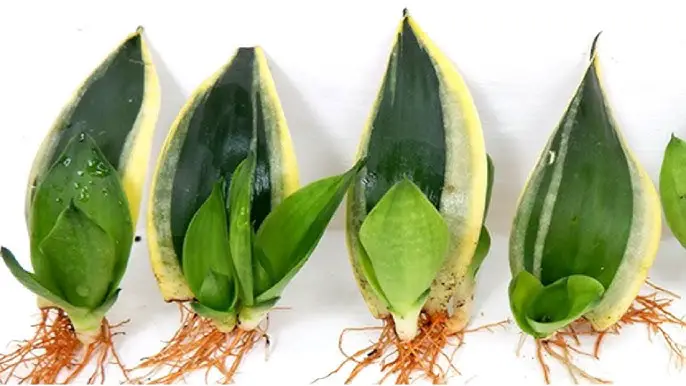Snake plants aren’t just beautiful—they’re resilient, low-maintenance, and surprisingly easy to multiply. If you’ve ever admired their bold, upright leaves and wished you had more, the good news is you don’t need to buy new plants. With a little time and care, you can turn one healthy snake plant into several, right from the comfort of your home.
Propagating snake plants is more than a gardening task—it’s a deeply rewarding experience. Watching new roots form and fresh leaves emerge is like witnessing a quiet miracle. Whether you’re a seasoned plant lover or just starting your indoor garden journey, learning how to propagate snake plant at home brings both joy and confidence to your green-thumbed adventures.
Why Propagate Snake Plants?

Propagating snake plants is one of the most rewarding and practical ways to expand your indoor plant collection. Instead of buying new plants, you can grow several healthy snake plants from just one original plant—saving money and reducing your environmental impact. It’s an easy, sustainable practice that gives you full control over how your plants grow, especially if you already have a mature or thriving specimen at home.
Propagation also plays a key role in plant health. As snake plants grow, they can become root-bound or overcrowded in their pots. Dividing the plant not only gives the original more room to breathe, but also encourages stronger, healthier growth in both the parent and the new offshoots. Leaf cuttings, another method of propagation, are perfect for rescuing broken or trimmed leaves that would otherwise go to waste.
This process is not only practical but also emotionally rewarding. Watching roots form and new shoots appear brings a sense of satisfaction and wonder—perfect for plant lovers of all experience levels. Whether you’re sharing plants with friends, creating green accents for more rooms in your home, or simply enjoying a deeper connection with your houseplants, propagating snake plants is an easy and meaningful way to grow your indoor garden with purpose and joy.
The Best Time to Propagate
The best time to propagate snake plants is during the spring and early summer months, when the plant is in its active growing phase. During this period, warmer temperatures and longer daylight hours naturally stimulate faster root and shoot development, giving your new cuttings or divisions the best chance to take root and thrive.
While snake plants can technically be propagated year-round indoors, results are often slower in fall and winter due to reduced light and cooler conditions, which can delay root formation and increase the risk of rot. If you must propagate during the off-season, make sure your plant is kept in a warm room with plenty of bright, indirect light, and be extra cautious with watering, as moisture takes longer to evaporate in cooler months.
Using the natural growth cycle to your advantage not only shortens propagation time but also supports healthier, more vigorous new plants. If possible, plan your propagation during the plant’s most active period for the best results.
Choosing a Healthy Mother Plant
Selecting a strong, healthy mother plant is one of the most important steps in successful snake plant propagation. A robust parent plant provides the energy and nutrients needed to support new root and shoot development, increasing the chances of success with both leaf cuttings and division.
Look for a snake plant with firm, upright leaves that are rich in color—whether green, variegated, or striped, the foliage should appear vibrant and free from fading or yellowing. Avoid plants with soft, mushy, or discolored leaves, as these may indicate rot or disease. Check the base of the plant and the soil surface for signs of pests, such as webbing, tiny bugs, or white residue, which can easily spread to new cuttings if not treated.
If you’re planning to divide the plant, ensure it has multiple leaf clusters or pups growing from the base. Each division should have at least one healthy leaf and a portion of the root system to support independent growth.
Before taking cuttings or separating the plant, make sure it is well-watered a few days in advance. This helps reduce stress and allows the plant to recover more quickly after propagation. A healthy mother plant sets the foundation for strong, beautiful offspring that will thrive with the right care.
Method 1: Leaf Cutting in Soil
Propagating snake plants using leaf cuttings in soil is one of the easiest and most accessible methods, especially for beginners. Although it takes time, it requires minimal tools and space, and it’s a great way to turn a single leaf into a new plant.
Start by selecting a mature, healthy leaf from the mother plant. Using a clean, sharp knife or scissors, cut the leaf near the base. If the leaf is large, you can cut it into multiple sections, each about 4–6 inches long. Just remember to keep track of which end was the bottom, as planting the cutting upside down will prevent rooting.
Allow each cutting to dry and callous for 1–2 days in a warm, dry place. This step is crucial—it helps seal the cut end and prevents rot when the cutting is placed in soil.
Once calloused, insert the base of each cutting about an inch deep into a well-draining potting mix, ideally a cactus or succulent soil blend. Gently press the soil around the cutting to support it upright. Water the soil lightly until just moist, and place the pot in a location with bright, indirect light. Avoid direct sun, which can dry out the cutting too quickly.
During the first few weeks, keep the soil slightly moist but never soggy. Overwatering is the most common cause of failure in this method. Rooting typically begins within 4–8 weeks, though new shoots may take several months to emerge.
While this method is simple and space-saving, keep in mind that variegated varieties may lose their patterns in the new plant and revert to solid green. Nonetheless, it’s a highly rewarding way to propagate and enjoy more of this tough, elegant houseplant.
Method 2: Leaf Cutting in Water
Water propagation is a simple and rewarding way to grow new snake plants, especially for those who enjoy watching roots form. Start by cutting a healthy leaf near the base, then trim it into 4–6 inch sections if desired. Let the cuttings dry for 1–2 days to callous and prevent rot.
Place the bottom end of each cutting in a glass of clean water, ensuring only the base is submerged. Keep the glass in bright, indirect light and change the water every 3–5 days. Roots typically begin to form within 2–4 weeks.
Once the roots are 1–2 inches long, transfer the cutting to a pot with well-draining soil. Water lightly and continue to provide indirect light. While variegated types may lose their patterns, this method is easy, clean, and ideal for plant lovers of all levels.
Method 3: Division of Rhizomes
Division of rhizomes is the fastest and most reliable way to propagate snake plants, especially if your plant is mature and has multiple growth points or “pups.” This method gives you fully rooted new plants instantly, with minimal risk and faster results than leaf cuttings.
Start by gently removing the mother plant from its pot. Shake off or rinse away excess soil so you can clearly see the root system. Snake plants grow from thick underground stems called rhizomes, which send up clusters of leaves. Identify natural separation points where the rhizomes have produced distinct clusters.
Using a clean, sharp knife or pruners, carefully cut between these clusters. Each division should have at least one healthy leaf and a portion of the root system attached. If the roots are dense and tangled, gently tease them apart with your fingers.
Prepare individual pots with fresh, well-draining soil, such as a cactus or succulent mix. Place each division into its own pot, fill in around the roots with soil, and water lightly. Keep the new plants in a warm spot with bright, indirect light and avoid overwatering while they establish.
Division is ideal when your plant is root-bound, too large for its pot, or starting to crowd itself with multiple offshoots. It’s also the best method to retain variegation and original plant characteristics, which are often lost with leaf cuttings.
With minimal effort, you’ll have strong, fully formed snake plants that can grow independently from day one.
Aftercare for New Snake Plants
Caring for your newly propagated snake plants properly ensures they take root and grow into healthy, thriving houseplants. Once transplanted, place them in a spot with bright, indirect sunlight—enough light helps encourage strong root development, but too much direct sun can scorch young or tender leaves.
Keep the environment warm and stable, ideally between 60–85°F (15–29°C). Avoid placing them near cold drafts, heaters, or air conditioning vents. If humidity is low, occasional light misting or using a humidity tray can help, especially during the first few weeks.
Water your new snake plants sparingly. Wait until the top inch of soil feels dry, then water lightly. Overwatering is one of the most common mistakes, especially while the roots are still forming. Make sure pots have proper drainage to avoid soggy soil, which can lead to rot.
Avoid fertilizing until you see new growth, usually 4–6 weeks after planting. Once established, feed once a month during spring and summer with a diluted, balanced liquid fertilizer.
If you’ve propagated from water and recently transferred the cutting to soil, be gentle during the transition. Monitor the moisture closely and let the plant slowly adjust to its new growing medium.
With patience and consistent care, your new snake plants will settle in, send up new shoots, and become resilient additions to your indoor plant family.
Common Mistakes to Avoid
When propagating snake plants, avoiding common pitfalls can greatly improve your success rate. One major mistake is overwatering, especially before roots have formed—always let the soil dry slightly between waterings. Using non-draining or heavy soil can also lead to root rot; choose a well-draining mix like cactus or succulent soil.
Skipping the callousing step after cutting leaves increases the risk of rot. Always let cuttings dry for 1–2 days before planting. Another error is placing cuttings in low light—bright, indirect light is key for healthy root growth.
Lastly, impatience is a common issue. Snake plants root slowly, often taking several weeks. Avoid disturbing cuttings too soon and allow time for roots to develop fully. By steering clear of these mistakes, your propagation efforts will be far more successful.
How Long Does Propagation Take?
Propagation of snake plants is a slow but rewarding process. The exact time depends on the method used, environmental conditions, and the health of the cuttings or divisions.
For leaf cuttings in soil or water, root development usually begins within 2 to 6 weeks, but it may take 2 to 3 months for visible new growth or pups to appear. Water-propagated cuttings often root slightly faster, but transferring them to soil adds an adjustment period.
With the division of rhizomes, results are much quicker. Since each section already has roots, the plant typically begins growing right away, with new leaves emerging in a few weeks under the right conditions.
Factors like temperature, light, humidity, and airflow can affect timing. Warmer temperatures (65–85°F), bright indirect light, and proper care help speed up the process. Cooler or low-light conditions may slow it down significantly.
In short, patience is key—most propagations take at least a few weeks to a few months to become fully established.
Benefits of Propagating Snake Plants at Home
Propagating snake plants at home offers a wide range of benefits, both practical and rewarding. First and foremost, it’s an affordable way to expand your plant collection. Instead of buying new plants, you can multiply your existing snake plant for free using just a few leaves or rhizome divisions.
Propagation is also an excellent method for plant rejuvenation. If your snake plant becomes leggy or overgrown, dividing or trimming it for cuttings helps refresh its appearance while creating healthy new plants.
It’s also a great learning experience, especially for beginners. The process teaches patience and plant care skills in a hands-on way. Watching roots form and new shoots grow is not only educational but deeply satisfying.
Additionally, home propagation allows you to share plants with friends and family, making it a thoughtful and sustainable gift. You can also use it to rescue damaged or broken leaves, turning what would be waste into something new and living.
Lastly, propagating your own plants fosters a stronger connection to nature and your home environment, encouraging mindfulness and daily engagement with the growing process.
Frequently Asked Questions About Propagate Snake Plant
How do I know if my snake plant cutting is rooting?
You can tell your cutting is rooting when it begins to feel firm in the soil or water, and small white roots appear at the base after 2–6 weeks. In water, roots are visible; in soil, gently tug after a few weeks—resistance often indicates roots have formed.
Can I propagate a snake plant from a single leaf?
Yes, a single healthy leaf can be used for propagation. Cut it into sections, let the pieces callous for a day or two, then place them in water or well-draining soil. Keep the bottom side down and be patient—rooting takes time but is very doable.
Why is my cutting turning mushy or yellow?
This usually means the cutting is rotting, often due to overwatering, poor drainage, or not letting it callous before planting. Remove any mushy parts, use a well-draining soil mix, and allow the cuttings to dry for 24–48 hours before replanting.
How long does it take for new growth to appear?
New leaves or pups can take 1 to 3 months to appear, depending on the method and conditions. Water propagation may show roots faster, but soil-rooted cuttings typically grow new shoots sooner after rooting. Keep them in warm, bright conditions.
Do I need to use rooting hormone?
Rooting hormone is optional for snake plants. They usually root well without it, especially in water. However, using rooting hormone on soil cuttings can slightly speed up the rooting process and reduce the risk of rot or failure.
Conclusion
Propagating snake plants at home is more than just a gardening task—it’s a journey of patience, care, and quiet joy. From a single leaf or rhizome, you can create new life, expand your green space, and deepen your connection with nature.
Whether you’re a seasoned plant parent or a curious beginner, propagation offers a chance to slow down, observe growth over time, and experience the simple satisfaction of nurturing something with your own hands. With the right knowledge and a bit of love, even the smallest cutting can grow into a thriving symbol of resilience and renewal in your home.






